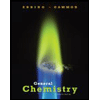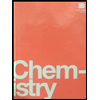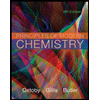
CHEMISTRY THE CENTRAL SCIENCE >EBOOK<
14th Edition
ISBN: 9780136873891
Author: Brown
Publisher: PEARSON
expand_more
expand_more
format_list_bulleted
Concept explainers
Textbook Question
Chapter 8, Problem 17E
Predict the chemical formula of the ionic compound formed between the following pairs of elements:
- Al and F,
- K and S,
- Y and 0,
- Mg and N.
Expert Solution & Answer
Trending nowThis is a popular solution!

Students have asked these similar questions
Pls help me on this q.
Given the elementary reactions in an aqueous medium with an ionic strength of 0.001:1) CH3Br + OH- → CH3OH + Br-2) ClCH2COO- + OH- → HOCH2COO- + Cl-3) [Co(NH3)5Br]2+ + NO2- →[Co(NH3)5NO2]2+ + Br-If the ionic strength is decreased, 1) k will not change; 2) k will decrease; and 3) k will increase. Is this correct?
Relate zero ionic strength and infinite dilution limit.
Chapter 8 Solutions
CHEMISTRY THE CENTRAL SCIENCE >EBOOK<
Ch. 8.2 - Which of the these elements is most likely to from...Ch. 8.2 - Prob. 8.1.2PECh. 8.2 - Which of the following bond is the most polar? H-F...Ch. 8.2 - Prob. 8.2.2PECh. 8.3 - Prob. 8.3.1PECh. 8.3 - Prob. 8.3.2PECh. 8.4 - Which of the following bonds is the most polar? a....Ch. 8.4 - Which of the following bonds is most polar: S-Cl,...Ch. 8.4 - Prob. 8.5.1PECh. 8.4 - The dipole moment of chlorine monofluoride,...
Ch. 8.5 - Which of the these molecules has a Lewis structure...Ch. 8.5 -
How many valence electrons should appear in the...Ch. 8.5 - Compare the lewis symbol for neon the structure...Ch. 8.5 - Prob. 8.7.2PECh. 8.5 - Prob. 8.8.1PECh. 8.5 - Prob. 8.8.2PECh. 8.5 - Prob. 8.9.1PECh. 8.5 - Prob. 8.9.2PECh. 8.6 - Which of the statements about resonance is true?...Ch. 8.6 - Prob. 8.10.2PECh. 8.7 - Prob. 8.11.1PECh. 8.7 - Prob. 8.11.2PECh. 8 - Prob. 1DECh. 8 - Prob. 1ECh. 8 - Prob. 2ECh. 8 - A portion of a two-dimensional "slab" of NaCl(s)...Ch. 8 - Prob. 4ECh. 8 - Prob. 5ECh. 8 - Incomplete Lewis structures for the nitrous acid...Ch. 8 - Prob. 7ECh. 8 - Prob. 8ECh. 8 - Prob. 9ECh. 8 - True or false: The hydrogen atom is most stable...Ch. 8 - Consider the element silicon, Si. Write its...Ch. 8 - Write the electron configuration for the element...Ch. 8 - Prob. 13ECh. 8 - What is the Lewis symbol for each of the following...Ch. 8 - Using Lewis symbols, diagram the reaction between...Ch. 8 - Use Lewis symbols to represent the reaction that...Ch. 8 - Predict the chemical formula of the ionic compound...Ch. 8 - Prob. 18ECh. 8 - Prob. 19ECh. 8 - Prob. 20ECh. 8 - Is lattice energy usually endothermic or...Ch. 8 - NaCI and KF have the same crystal structure. The...Ch. 8 - Prob. 23ECh. 8 - Prob. 24ECh. 8 - Consider the ionic compounds KF, NaCl, NaBr, and...Ch. 8 - Which of the following trends in lattice energy is...Ch. 8 - Energy is required to remove two electrons from Ca...Ch. 8 - Prob. 28ECh. 8 - Use data from Appendix C, Figure 7.10, and Figure...Ch. 8 - Prob. 30ECh. 8 - Prob. 31ECh. 8 - Prob. 32ECh. 8 - Using Lewis symbols and Lewis structures, diagram...Ch. 8 - Use Lewis symbols and Lewis structures to diagram...Ch. 8 - Prob. 35ECh. 8 - Prob. 36ECh. 8 - Prob. 37ECh. 8 - What is the trend in electronegativity going from...Ch. 8 - Prob. 39ECh. 8 - By referring only to the periodic table, select...Ch. 8 - which of the following bonds are polar? B-F,...Ch. 8 - Arrange the bonds in each of the following sets in...Ch. 8 - Prob. 43ECh. 8 - Prob. 44ECh. 8 - In the following pairs of binary compounds,...Ch. 8 - Prob. 46ECh. 8 - Prob. 47ECh. 8 - Write Lewis structures for the following: H2CO...Ch. 8 - Prob. 49ECh. 8 - Draw the dominant Lewis structure for the...Ch. 8 - Write Lewis structures that obey the octet rule...Ch. 8 - Prob. 52ECh. 8 - Prob. 53ECh. 8 - Prob. 54ECh. 8 - Prob. 55ECh. 8 - Prob. 56ECh. 8 - Prob. 57ECh. 8 - Prob. 58ECh. 8 - Prob. 59ECh. 8 - Prob. 60ECh. 8 - Prob. 61ECh. 8 - 8.62 For Group 3A-7A elements in the third row of...Ch. 8 - Draw the Lewis structures for each of the...Ch. 8 - Prob. 64ECh. 8 - In the vapor phase, BeCl2exists as a discrete...Ch. 8 -
8.66
Describe the molecule xenon trioxide, XeO3,...Ch. 8 -
8.67 There are many Lewis structures you could...Ch. 8 - Prob. 68ECh. 8 - Using Table 8.3, estimate H for each of the...Ch. 8 - Using Table 8.3, estimate H for the following...Ch. 8 - State whether each of these statements is true or...Ch. 8 - Prob. 72ECh. 8 - Prob. 73ECh. 8 - Prob. 74ECh. 8 - Prob. 75ECh. 8 - Prob. 76ECh. 8 - A new compound is made that has a C-C bond length...Ch. 8 - A new compound is made that has an N-N bond length...Ch. 8 - Prob. 79AECh. 8 - Prob. 80AECh. 8 - An ionic substance of formula MX has a lattice...Ch. 8 - Prob. 82AECh. 8 - Prob. 83AECh. 8 - Prob. 84AECh. 8 - Consider the collection of nonmetallic elements 0,...Ch. 8 - The substance chlorine monoxide, CIO(g), is...Ch. 8 -
[8.87]
a. using the electronegativities of Br...Ch. 8 - Prob. 88AECh. 8 - Although I3- is a known ion, F3- is not. a. Draw...Ch. 8 - Calculate the formal charge on the indicated atom...Ch. 8 - The hypochlorite ion, CIO- , is the active...Ch. 8 - Prob. 92AECh. 8 - a. Triazine, C3 H3N3, is like benzene except that...Ch. 8 - Prob. 94IECh. 8 - Prob. 95IECh. 8 - Prob. 96IECh. 8 - Prob. 97IECh. 8 - Prob. 98IECh. 8 - Prob. 99IECh. 8 - Prob. 100IECh. 8 - Prob. 101IECh. 8 - Prob. 102IECh. 8 -
8.103 The compound chloral hydrate, known in...Ch. 8 - Barium azide is 62.04% Ba and 37.96% N. Each azide...Ch. 8 - Acetylene (C2H2) and nitrogen (N2) both contain a...Ch. 8 - Prob. 106IECh. 8 - Prob. 107IECh. 8 -
8.108 Formic acid has the chemical formula...Ch. 8 - Prob. 109IECh. 8 - Prob. 110IE
Knowledge Booster
Learn more about
Need a deep-dive on the concept behind this application? Look no further. Learn more about this topic, chemistry and related others by exploring similar questions and additional content below.Similar questions
- The photolysis of H3C–N=N–C2H5 involves the breaking of the single bonds shown. According to this, in addition to N2, what products would be obtained primarily if the reaction were carried out in the gas phase or in solution in an inert solvent?arrow_forwardGiven a keto-enol tautomerization reaction, which is greatly influenced by the type of solvent, indicate which of the following solvent properties cannot be considered a "solvent effect"?(A) Dielectric constant(B) Polarity(C) Hydrogen bonding capacity(D) Temperaturearrow_forwardIn solution reactions, what does "solvent effect" mean?arrow_forward
- How to solvearrow_forwardIndicate the concentration and ionic strength ranges to which the Debye-Huckel equation can be applied. And the Davies equation?arrow_forwardIf the ionic strength (I) of a solution is very low, the Debye-Huckel equation is used. If I is higher, the Davies equation is used. What is the correct value for I to use one or the other?arrow_forward
- In both the Debye-Huckel equation and the Davies equation, there is a constant A. I see that sometimes it appears as 0.51 and other times as 1.02. Explain why one or the other value is used.arrow_forwardThe two equations are forms of the Davies equation, used in thermodynamics for activity coefficients: ال log Y₁ = -Az² - 0,31 log = Az² - 0,31 1 + √Ĩ 1 + √√ k These equations are consistent and imply that Yi = Is this last equation correct? karrow_forwardThe two equations are forms of the Davies equation, used in thermodynamics for activity coefficients: ال log Y₁ = -Az² - 0,31 log = Az² - 0,31 1 + √Ĩ 1 + √√ k These equations are consistent and imply that Yi = Is this last equation correct? karrow_forward
- For the Davies equation, both expressions are correct: log Y₁ = -Az² √i - 0,31 1 + √ k log- = Az - 0,31 k 1 + √Ĩarrow_forwardk In Davies' equation log y₁ = log- log y₁ = log | = -Az² + ✓// k A is a constant that always equals 1.02. Correct? - 0,31arrow_forwardIndicate whether the equality is true Yi How is it obtained? k%arrow_forward
arrow_back_ios
SEE MORE QUESTIONS
arrow_forward_ios
Recommended textbooks for you
 General Chemistry - Standalone book (MindTap Cour...ChemistryISBN:9781305580343Author:Steven D. Gammon, Ebbing, Darrell Ebbing, Steven D., Darrell; Gammon, Darrell Ebbing; Steven D. Gammon, Darrell D.; Gammon, Ebbing; Steven D. Gammon; DarrellPublisher:Cengage Learning
General Chemistry - Standalone book (MindTap Cour...ChemistryISBN:9781305580343Author:Steven D. Gammon, Ebbing, Darrell Ebbing, Steven D., Darrell; Gammon, Darrell Ebbing; Steven D. Gammon, Darrell D.; Gammon, Ebbing; Steven D. Gammon; DarrellPublisher:Cengage Learning Chemistry by OpenStax (2015-05-04)ChemistryISBN:9781938168390Author:Klaus Theopold, Richard H Langley, Paul Flowers, William R. Robinson, Mark BlaserPublisher:OpenStax
Chemistry by OpenStax (2015-05-04)ChemistryISBN:9781938168390Author:Klaus Theopold, Richard H Langley, Paul Flowers, William R. Robinson, Mark BlaserPublisher:OpenStax Principles of Modern ChemistryChemistryISBN:9781305079113Author:David W. Oxtoby, H. Pat Gillis, Laurie J. ButlerPublisher:Cengage Learning
Principles of Modern ChemistryChemistryISBN:9781305079113Author:David W. Oxtoby, H. Pat Gillis, Laurie J. ButlerPublisher:Cengage Learning Chemistry: Principles and PracticeChemistryISBN:9780534420123Author:Daniel L. Reger, Scott R. Goode, David W. Ball, Edward MercerPublisher:Cengage Learning
Chemistry: Principles and PracticeChemistryISBN:9780534420123Author:Daniel L. Reger, Scott R. Goode, David W. Ball, Edward MercerPublisher:Cengage Learning Living By Chemistry: First Edition TextbookChemistryISBN:9781559539418Author:Angelica StacyPublisher:MAC HIGHER
Living By Chemistry: First Edition TextbookChemistryISBN:9781559539418Author:Angelica StacyPublisher:MAC HIGHER Chemistry: An Atoms First ApproachChemistryISBN:9781305079243Author:Steven S. Zumdahl, Susan A. ZumdahlPublisher:Cengage Learning
Chemistry: An Atoms First ApproachChemistryISBN:9781305079243Author:Steven S. Zumdahl, Susan A. ZumdahlPublisher:Cengage Learning

General Chemistry - Standalone book (MindTap Cour...
Chemistry
ISBN:9781305580343
Author:Steven D. Gammon, Ebbing, Darrell Ebbing, Steven D., Darrell; Gammon, Darrell Ebbing; Steven D. Gammon, Darrell D.; Gammon, Ebbing; Steven D. Gammon; Darrell
Publisher:Cengage Learning

Chemistry by OpenStax (2015-05-04)
Chemistry
ISBN:9781938168390
Author:Klaus Theopold, Richard H Langley, Paul Flowers, William R. Robinson, Mark Blaser
Publisher:OpenStax

Principles of Modern Chemistry
Chemistry
ISBN:9781305079113
Author:David W. Oxtoby, H. Pat Gillis, Laurie J. Butler
Publisher:Cengage Learning

Chemistry: Principles and Practice
Chemistry
ISBN:9780534420123
Author:Daniel L. Reger, Scott R. Goode, David W. Ball, Edward Mercer
Publisher:Cengage Learning

Living By Chemistry: First Edition Textbook
Chemistry
ISBN:9781559539418
Author:Angelica Stacy
Publisher:MAC HIGHER

Chemistry: An Atoms First Approach
Chemistry
ISBN:9781305079243
Author:Steven S. Zumdahl, Susan A. Zumdahl
Publisher:Cengage Learning
Calorimetry Concept, Examples and Thermochemistry | How to Pass Chemistry; Author: Melissa Maribel;https://www.youtube.com/watch?v=nSh29lUGj00;License: Standard YouTube License, CC-BY